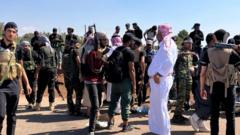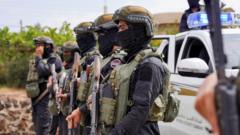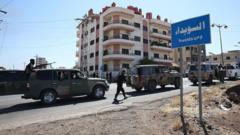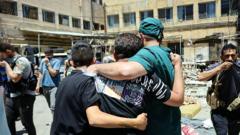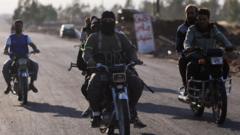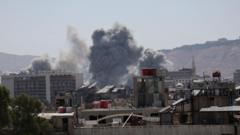After the fall of Bashar al-Assad, Syria has witnessed a significant surge in social freedoms and cultural expressions. Citizens who had long been silenced under the oppressive regime of both Bashar and his father Hafez are now openly debating politics, with many returning from exile to participate in the nation's renewal. Cafes that once echoed with whispers of fear are now filled with laughter and discourse, marking a stark contrast to years of repression. However, the landscape has become increasingly complicated. Challenges loom over the potential for democratic governance and the preservation of individual rights, particularly concerning women's liberties and religious freedoms. The newly appointed leadership, led by interim President Ahmed al-Sharaa, faces skepticism regarding their commitment to genuine political participation and inclusion. Meanwhile, societal tensions brew as various factions vie for influence, raising questions about the enduring stability and freedom of the Syrian populace. As optimism blends with apprehension, many wonder if the hard-fought liberties will endure or succumb to emerging authoritarianism in a nation still healing from the scars of war.
Assessing Syria's Newfound Freedoms: A Fragile Future Ahead?
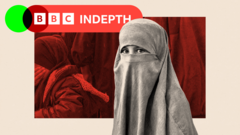
Assessing Syria's Newfound Freedoms: A Fragile Future Ahead?
Syria experiences a cultural and social renaissance post-Assad, but democracy remains uncertain amidst rising concerns.
On December 8, 2024, anticipation buzzed at the Lebanese border as I prepared to return to Syria, a country forever altered by the removal of President Bashar al-Assad after more than 24 years in power. The change came unexpectedly fast; opposition fighters surged towards Damascus, reclaiming cities like Aleppo with astonishing speed. I had only known Syria under the Assads—a legacy marred by decades of oppression, disappearances, and brutal civil war.
During my earlier years in Syria, I faced detention and witnessed unimaginable atrocities as the vibrant pulse of dissent was met with iron-fisted repression. I left in 2013, convinced I would never return to my homeland again. Yet, on crossing the border back into Syria years later, I felt a mix of disbelief and elation as I joined a throng of citizens celebrating Assad's fall in the streets.
For weeks after the regime's collapse, Damascus transformed into a lively tapestry of discussion and debate. In Umayyad Square, citizens of all ages engaged freely in dialogue where previously such open expression was impossible. This shift brought newfound social freedoms, but now, just months later, questions arise: How long can these freedoms thrive amidst burgeoning tensions and potential power struggles?
At a gathering in Rawda Café, a former hub for regime informants, I listened to returning intellectuals, including journalists and writers like Mohammad Ghannam and Odai al-Zobi, who reflected on the immense change. Once silenced, they spoke excitedly about the artistic revival occurring across Syria, where banned books and films were now publicly accessible. The interim leadership has yet to confirm its commitment to preserving these liberties, with fears that religious conservative elements could threaten cultural expression.
The interim President, Ahmed al-Sharaa, who emerged from the rebel movement, is expected to build a democracy. However, as the months progress, concerns linger regarding his and his administration's dedication to inclusivity and representative governance. An early national dialogue event faced criticism for its lack of broad representation, indicating potential challenges ahead.
Notably, the roles of women and religious minorities remain uncertain in this new chapter, sparking apprehension among advocates for rights and freedoms. While Assad's era offered relative equality for women, their representation has markedly dwindled in the interim government. Moreover, some detect signs of rising religious conservatism that could challenge established norms of tolerance within Syrian society.
As competing visions for Syria's future clash, violence and unrest in various regions add layers of complexity to an already fragile situation. Many citizens harbor wariness that without meaningful democratization, Syria may face yet another period of oppression, possibly leading to a resurgence of authoritarian rule.
In conclusion, while Syrians have embraced newfound freedoms with joyous celebration, the road ahead remains fraught with uncertainty. Whether this revolution will cultivate genuine democracy or repeat the failings of the past depends on the willingness of the interim government to engage in inclusive dialogue and earn public trust. As voices of dissent persist and the specter of old regimes looms, the question remains: Can Syria craft a democratic future, or is it fated to repeat its history of dictatorship and desolation?
During my earlier years in Syria, I faced detention and witnessed unimaginable atrocities as the vibrant pulse of dissent was met with iron-fisted repression. I left in 2013, convinced I would never return to my homeland again. Yet, on crossing the border back into Syria years later, I felt a mix of disbelief and elation as I joined a throng of citizens celebrating Assad's fall in the streets.
For weeks after the regime's collapse, Damascus transformed into a lively tapestry of discussion and debate. In Umayyad Square, citizens of all ages engaged freely in dialogue where previously such open expression was impossible. This shift brought newfound social freedoms, but now, just months later, questions arise: How long can these freedoms thrive amidst burgeoning tensions and potential power struggles?
At a gathering in Rawda Café, a former hub for regime informants, I listened to returning intellectuals, including journalists and writers like Mohammad Ghannam and Odai al-Zobi, who reflected on the immense change. Once silenced, they spoke excitedly about the artistic revival occurring across Syria, where banned books and films were now publicly accessible. The interim leadership has yet to confirm its commitment to preserving these liberties, with fears that religious conservative elements could threaten cultural expression.
The interim President, Ahmed al-Sharaa, who emerged from the rebel movement, is expected to build a democracy. However, as the months progress, concerns linger regarding his and his administration's dedication to inclusivity and representative governance. An early national dialogue event faced criticism for its lack of broad representation, indicating potential challenges ahead.
Notably, the roles of women and religious minorities remain uncertain in this new chapter, sparking apprehension among advocates for rights and freedoms. While Assad's era offered relative equality for women, their representation has markedly dwindled in the interim government. Moreover, some detect signs of rising religious conservatism that could challenge established norms of tolerance within Syrian society.
As competing visions for Syria's future clash, violence and unrest in various regions add layers of complexity to an already fragile situation. Many citizens harbor wariness that without meaningful democratization, Syria may face yet another period of oppression, possibly leading to a resurgence of authoritarian rule.
In conclusion, while Syrians have embraced newfound freedoms with joyous celebration, the road ahead remains fraught with uncertainty. Whether this revolution will cultivate genuine democracy or repeat the failings of the past depends on the willingness of the interim government to engage in inclusive dialogue and earn public trust. As voices of dissent persist and the specter of old regimes looms, the question remains: Can Syria craft a democratic future, or is it fated to repeat its history of dictatorship and desolation?



